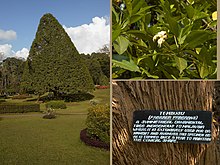Tembusu
| Tembusu | |
|---|---|

| |
| Scientific classification | |
| Kingdom: | Plantae |
| Clade: | Tracheophytes |
| Clade: | Angiosperms |
| Clade: | Eudicots |
| Clade: | Asterids |
| Order: | Gentianales |
| Family: | Gentianaceae |
| Genus: | Cyrtophyllum |
| Species: | C. fragrans
|
| Binomial name | |
| Cyrtophyllum fragrans | |
| Synonyms | |
| |

The tembusu is a large evergreen tree in the family Gentianaceae, native to Southeast Asia (from Indo-China to New Guinea). It is the Malay name for Cyrtophyllum fragrans (synonym Fagraea fragrans).[1]
Its trunk is dark brown, with deeply fissured bark, looking somewhat like a bittergourd. The tree grows in an irregular shape from 10 to 25 metres high,[2] with light green oval-shaped leaves, and yellowish flowers with a distinct fragrance. The fruits of the tree are bitter tasting red berries, which are eaten by Pteropus fruit bats.[3]
Common names
Buabua (Fiji Islands), Urung (Philippines), Temasuk (Sabah), Tatrao, Trai (Vietnam), Kan Krao (Thailand), Tembesu (Indonesia), Anan, Anama (Burma), Munpla (Thailand, Laos), Ta Trao (Cambodia).[citation needed]
Uses
The trunk of this tree can produce very hard wood that can be used to make chopping boards.[citation needed]
The wood can last over a hundred years, particularly as termites and weevils do not eat this kind of wood. People always use this wood for creating the floors of their homes and love to sleep on it.[citation needed]
Cultural significance
The tree is pictured on the Singaporean five-dollar bill.[citation needed]
In Thailand, it is the provincial tree of Surin Province and the university tree of Ubonratchathani.[citation needed]
References
- ^ POWO: Cyrtophyllum fragrans (Roxb.) DC. (retrieved 12 November 2020)
- ^ Tropical plants site description
- ^ Hargreaves, Dorothy; Hargreaves, Bob (1970). Tropical Trees of the Pacific. Kailua, Hawaii: Hargreaves. p. 61.
- Note: Fagraea cochinchinensis is now considered a synonym of Aidia cochinchinensis
External links
 Data related to Cyrtophyllum fragrans at Wikispecies
Data related to Cyrtophyllum fragrans at Wikispecies Media related to Fagraea fragrans at Wikimedia Commons
Media related to Fagraea fragrans at Wikimedia Commons- Description from a woods supply site
